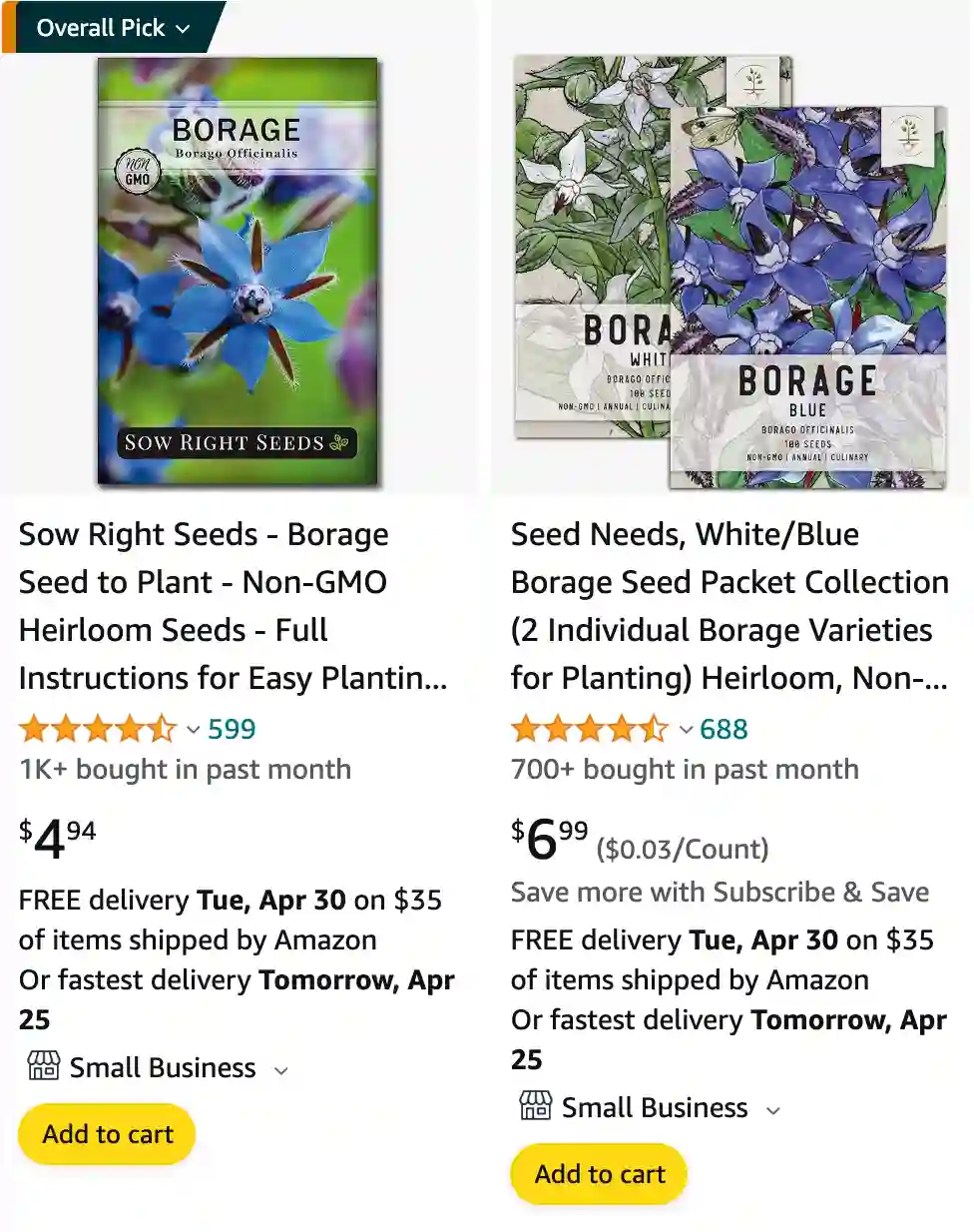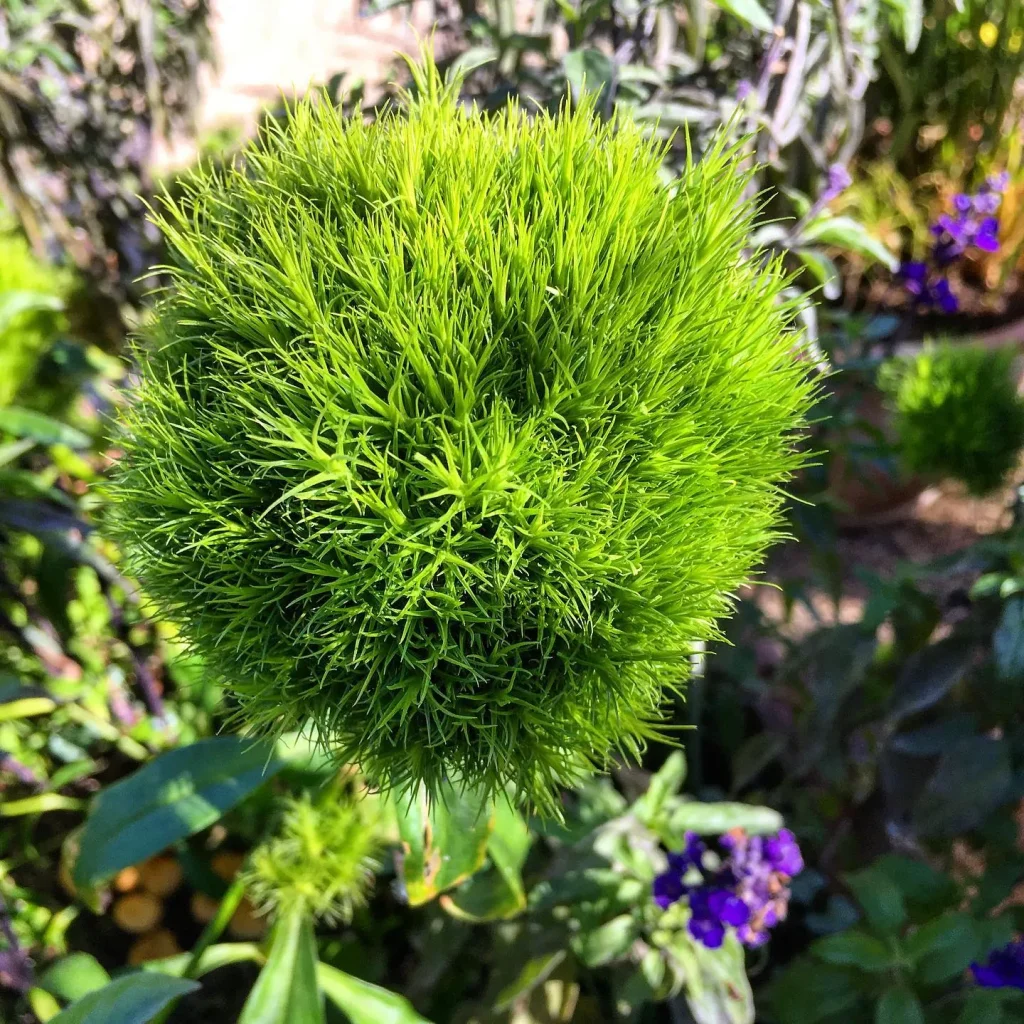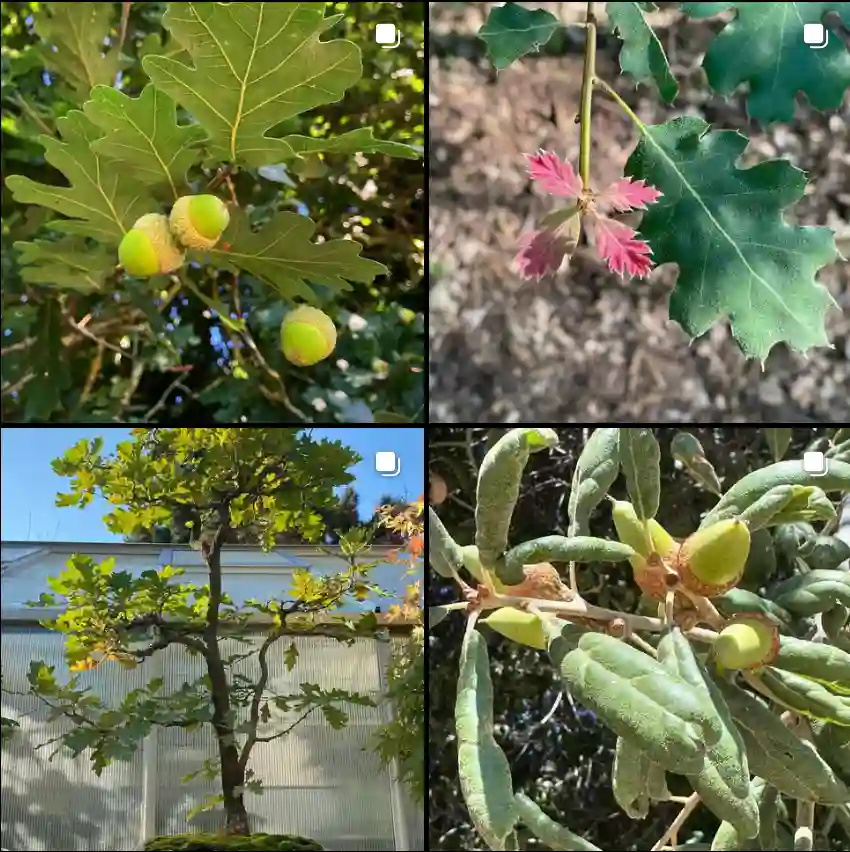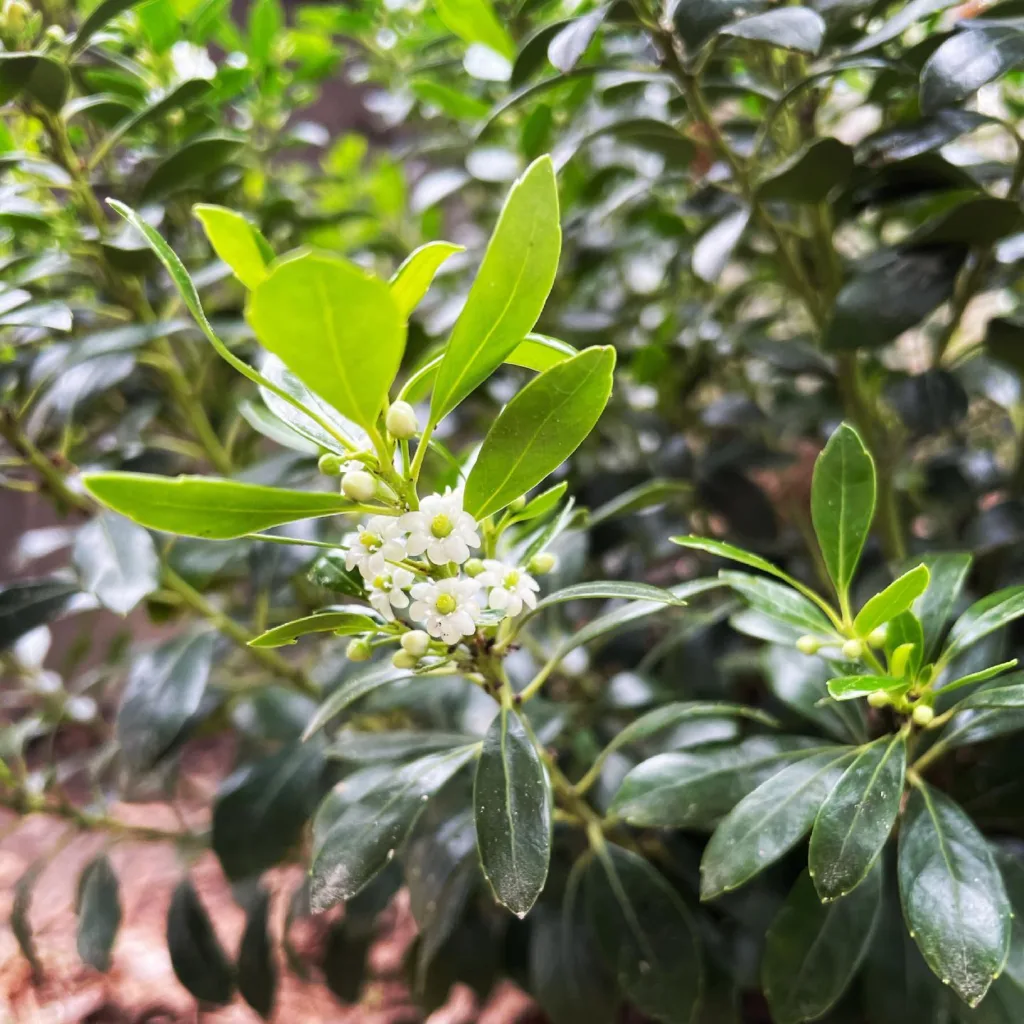
What is borage?
Borage is this amazing herb that I discovered when I started gardening a few years back. I remember being drawn to its vibrant blue flowers that seemed to sparkle in the sunlight. It’s not just pretty though; it has this subtle cucumber-like taste that adds a refreshing twist to salads and drinks. I love growing it because it’s incredibly easy to care for and attracts bees to my garden, which is great for pollination. Plus, it’s a versatile plant—you can use the leaves, flowers, and even the stems in various culinary creations. Overall, borage has become a staple in my garden, adding both beauty and flavor to my outdoor space.
Is borage a perennial?
Borage is actually an annual herb, which means it completes its life cycle within a single growing season. I remember learning this when I first started gardening and was researching which plants to include in my garden. Unlike perennials that come back year after year, borage grows from seed, matures, flowers, sets seed, and then dies, all within one year. It’s a bit of a bummer that I have to replant it each spring, but the joy it brings to my garden makes it totally worth it. Plus, since it readily self-seeds, I often find new borage plants popping up in unexpected places, which is a pleasant surprise!
What not to plant with borage?
When it comes to planting companions for borage, there are a few things I’ve learned through trial and error. While borage is great for attracting pollinators and enhancing the flavor of nearby plants, it’s best to avoid planting it alongside certain vegetables, like tomatoes and cucumbers. I made the mistake of planting them too close together once, and it seemed like the borage overshadowed the growth of my tomatoes and cucumbers. I think it might have to do with borage’s rapid growth and spreading nature, which can sometimes outcompete neighboring plants for resources like sunlight and nutrients. Since then, I’ve been more mindful of giving my borage some space from other veggies to thrive without crowding them out.
Does borage oil cause weight gain?
In my experience, I haven’t noticed borage oil causing weight gain when used in moderation. I’ve actually used borage oil supplements in the past for its potential health benefits, particularly for skin and joint health. However, like with any supplement, it’s essential to be mindful of dosage and consult with a healthcare professional, especially if you have concerns about weight management. From what I’ve researched, borage oil is rich in gamma-linolenic acid (GLA), which some studies suggest may have anti-inflammatory properties and could potentially support weight management by promoting a healthy metabolism. Overall, I think it’s crucial to approach any supplement with a balanced perspective and listen to your body’s responses to determine what works best for you.
Does borage oil increase estrogen?
From what I’ve learned, borage oil contains gamma-linolenic acid (GLA), which is an omega-6 fatty acid. There have been some discussions about GLA potentially affecting hormone levels, including estrogen. Some studies suggest that GLA might have a mild effect on hormone balance, but the evidence is not definitive. Personally, I haven’t noticed any significant changes in estrogen levels when using borage oil supplements, but it’s essential to approach any supplement with caution and consult with a healthcare professional, especially if you have concerns about hormone balance or specific health conditions. It’s always wise to consider individual factors and potential interactions before incorporating any new supplement into your routine.
What is borage good for?
Borage has a wide range of uses and benefits that I’ve come to appreciate over time. For one, it’s great for attracting beneficial insects like bees to my garden, which is essential for pollination and overall biodiversity. Plus, both the leaves and flowers are edible and have a mild, cucumber-like flavor that adds a refreshing twist to salads, drinks, and other culinary creations. I’ve also read about its potential health benefits, particularly from its oil, which contains gamma-linolenic acid (GLA), an omega-6 fatty acid that some studies suggest may have anti-inflammatory properties and could support skin and joint health. Overall, I love borage for its versatility, beauty, and the positive impact it has on both my garden and my well-being.
How to grow borage?
Growing borage is a breeze, and I’ve had great success with it in my garden! To get started, I usually sow borage seeds directly into well-drained soil in a sunny spot in my garden after the last frost date has passed. I like to space the seeds about 12 to 18 inches apart to give them plenty of room to grow. Borage isn’t too picky about soil quality, but it does appreciate fertile, slightly alkaline soil. Once planted, I water the seeds gently to keep the soil moist until they germinate, which usually takes about 7 to 14 days.
Once the seedlings emerge, they grow rapidly, and I’ve found that they don’t require much maintenance. I make sure to water them regularly, especially during dry spells, but otherwise, they’re pretty resilient. One thing to keep in mind is that borage has a tendency to self-seed, so you might find new plants popping up in unexpected places the following year. If you want to control its spread, you can deadhead the flowers before they go to seed.
What is borage used for?
Borage has a variety of uses that make it a valuable addition to both culinary and medicinal practices. In the kitchen, its leaves and flowers are often used as a flavorful and decorative ingredient in salads, soups, and drinks. Its mild, cucumber-like taste adds a refreshing touch to dishes, and its vibrant blue flowers make for an eye-catching garnish. Additionally, borage is known for its potential health benefits, particularly from its oil, which contains gamma-linolenic acid (GLA). Some studies suggest that GLA may have anti-inflammatory properties and could support skin and joint health. Borage oil supplements are sometimes used for these purposes, although it’s essential to consult with a healthcare professional before incorporating them into your routine. Overall, borage is valued for its versatility in the kitchen and its potential contributions to well-being.
When to plant borage?
Borage is typically best planted in the spring after the last frost date has passed. In temperate climates, this is usually around mid to late spring. Planting borage during this time allows it to establish and grow during the warmer months when it thrives. Borage seeds can be sown directly into the soil where you want them to grow, as they don’t transplant well due to their long taproot. So, once the soil has warmed up and all risk of frost has passed, you can sow borage seeds directly into your garden bed or container. With proper care and attention, you’ll soon have beautiful borage plants gracing your garden.
How tall does borage grow?
Borage plants can vary in height, but on average, they typically grow to be about 2 to 3 feet tall. However, in ideal conditions, they can sometimes reach heights of up to 4 feet or even taller. When I’ve grown borage in my garden, I’ve noticed that they tend to grow quite vigorously, with long stems and abundant foliage. The height of borage plants can also depend on factors like soil quality, sunlight, and water availability. Overall, borage’s tall stature adds a lovely vertical element to the garden, and its beautiful blue flowers create a striking visual impact.
How to harvest borage?
Harvesting borage is a straightforward process, and I’ve found it quite enjoyable. When the plant is in full bloom, usually in the summer months, that’s the best time to harvest both the leaves and flowers. I like to use sharp scissors or garden shears to carefully cut the leaves and flowers from the plant. For the leaves, I simply snip them off close to the stem, taking care not to damage the plant. As for the flowers, I prefer to harvest them in the morning when they’re at their freshest and most vibrant. I gently pinch off the flowers, making sure to leave a bit of stem attached. After harvesting, I give the leaves and flowers a quick rinse with water to remove any dirt or debris, and then they’re ready to be used in culinary creations or enjoyed fresh in salads and drinks. It’s a simple process that allows me to enjoy the beauty and flavor of borage throughout the growing season.
Is borage edible?
Yes, both the leaves and flowers of borage are edible! In fact, they are not only edible but also quite flavorful and versatile. The leaves have a mild, cucumber-like taste, while the flowers add a subtle sweetness and a beautiful pop of color to dishes. I enjoy using borage leaves and flowers in salads, soups, and drinks to add a refreshing twist to my culinary creations. They can also be used as a decorative garnish or infused into oils and vinegars for added flavor. Just make sure to wash them thoroughly before consuming, and if you’re harvesting them from your garden, avoid using any plants that have been treated with pesticides or other chemicals. Overall, borage is a delightful and nutritious addition to any kitchen.
Is borage invasive?
Borage can be considered invasive in some regions, particularly if it’s allowed to self-seed freely and spread unchecked. While I appreciate its ability to self-sow and fill in gaps in my garden, I’ve learned to keep a close eye on its spread to prevent it from taking over other plants. Borage produces a lot of seeds, and if conditions are favorable, it can quickly establish itself and outcompete neighboring plants. To manage its growth, I make sure to deadhead the flowers before they go to seed, and I also pull up any seedlings that appear in unwanted areas. With a bit of attention and care, I’ve found that I can enjoy the benefits of borage in my garden without letting it become overly invasive.
How to make borage tea?
Making borage tea is a simple and delightful process. Here’s how I like to do it:
- Harvest fresh borage leaves and flowers from your garden, making sure to wash them thoroughly to remove any dirt or debris.
- Boil water in a kettle or pot.
- Place the clean borage leaves and flowers in a teapot or heatproof container.
- Once the water has come to a boil, pour it over the borage leaves and flowers.
- Let the borage steep in the hot water for about 5 to 10 minutes, depending on how strong you like your tea.
- After steeping, strain the tea to remove the leaves and flowers, or you can leave them in if you prefer a more rustic presentation.
- Pour the borage tea into cups or mugs, and enjoy it hot or let it cool for a refreshing iced tea.
Borage tea has a mild, cucumber-like flavor with subtle floral notes, making it a soothing and refreshing beverage. You can also add a bit of honey or lemon to taste if desired. It’s a lovely way to enjoy the flavors and benefits of borage straight from your garden!
What does borage look like?
Borage is a beautiful and distinctive herb with several identifying features. It typically has hairy, rough-textured leaves that are a vibrant shade of green and are arranged alternately along the stem. The leaves are lance-shaped with deep veins and may vary in size but are generally large and broad. One of the most striking features of borage is its flowers, which are star-shaped and come in shades of blue, ranging from pale blue to deep azure. Each flower has five petals and a prominent central cone of black or purple stamens. Borage plants can grow quite tall, reaching heights of up to 2 to 3 feet or more, and they have a bushy, spreading growth habit. Overall, borage is a visually stunning plant that adds beauty and charm to any garden with its bright green foliage and dazzling blue flowers.
What does borage taste like?
Borage has a unique and delightful flavor that’s often described as reminiscent of cucumber. When you taste borage leaves or flowers, you’ll notice a subtle, refreshing taste that carries hints of cucumber with a slight herbal undertone. It’s a mild and pleasant flavor that adds a refreshing twist to salads, drinks, and other culinary creations. Personally, I find the taste of borage to be crisp and cooling, making it a perfect addition to summery dishes and beverages. Whether used fresh in salads or steeped into tea, borage brings a refreshing and distinctive flavor that’s sure to delight the palate.
Can chickens eat borage?
Yes, chickens can eat borage! Borage is safe and non-toxic for chickens to consume, and it can even be a nutritious addition to their diet. Chickens can peck at borage leaves and flowers, and they may enjoy foraging for them in the garden. Borage leaves are rich in vitamins and minerals, including vitamin C, calcium, and potassium, which can contribute to the overall health and well-being of chickens. Additionally, borage is known to attract beneficial insects like bees to the garden, which can provide additional food sources for chickens. Just make sure that any plants you offer to your chickens are free from pesticides or other chemicals, and always introduce new foods gradually to monitor their response. Overall, borage can be a tasty and nutritious treat for chickens to enjoy as part of a varied diet.
How to make borage oil?
Making borage oil at home is a simple process that requires just a few steps and some basic equipment. Here’s a general method for making infused borage oil:
- Harvest fresh borage flowers from your garden, making sure they are clean and free from dirt or debris. You can also use dried borage flowers if fresh ones are not available.
- Place the borage flowers in a clean, dry glass jar.
- Pour a carrier oil of your choice over the borage flowers until they are fully submerged. Common carrier oils used for infusions include olive oil, jojoba oil, or sweet almond oil.
- Seal the jar tightly with a lid and place it in a warm, sunny spot, such as a windowsill, for about 4 to 6 weeks. During this time, the oil will gradually take on the flavor and properties of the borage flowers.
- Shake the jar gently every few days to help distribute the flower essence throughout the oil.
- After the infusion period is complete, strain the oil through a fine mesh sieve or cheesecloth into a clean glass container to remove the borage flowers and any sediment.
- Store the infused borage oil in a cool, dark place, away from direct sunlight, to maintain its freshness and potency.
That’s it! You now have homemade borage-infused oil ready to use in culinary dishes, skincare products, or for its potential health benefits. Just remember to label your oil with the date it was made and the type of carrier oil used for future reference.
Is borage toxic to dogs?
Borage is generally considered safe for dogs in small quantities, but it’s essential to exercise caution and moderation. While borage is not known to be toxic to dogs, it’s possible that consuming large amounts of the plant could cause gastrointestinal upset or other digestive issues in some dogs. Additionally, some dogs may have allergic reactions to borage or other plants in the same family, so it’s a good idea to monitor your dog closely after introducing borage into their diet for the first time.
As with any new food or plant, it’s best to introduce borage to your dog gradually and in small amounts to gauge their reaction. If you notice any signs of discomfort or unusual behavior after your dog consumes borage, such as vomiting, diarrhea, or lethargy, it’s important to contact your veterinarian for advice.
Overall, while borage is generally safe for dogs, it’s always best to err on the side of caution and consult with a veterinarian if you have any concerns about your dog’s health or diet.
When to start borage seeds indoors?
Borage seeds are typically best sown directly into the garden soil rather than starting them indoors. This is because borage has a taproot that doesn’t transplant well, so it’s better to sow the seeds directly where you want the plants to grow.
However, if you’re in a region with a short growing season or you want to get a head start on the growing season, you can start borage seeds indoors about 4 to 6 weeks before the last frost date in your area. Use biodegradable pots or seedling trays filled with potting soil, and plant the seeds about 1/4 inch deep. Keep the soil moist and provide plenty of light for the seedlings to grow.
Once the seedlings have developed a few sets of true leaves and the threat of frost has passed, you can transplant them into the garden. Be sure to harden off the seedlings first by gradually exposing them to outdoor conditions before planting them in their final location.
Starting borage seeds indoors can be a bit trickier due to their taproot, but with proper care and attention, it can be done successfully to extend the growing season.
Where to buy borage?
You can buy borage seeds or plants from a variety of sources, including local nurseries, garden centers, and online seed suppliers. Many garden supply stores carry borage seeds or seedlings, especially during the spring and summer months when gardening season is in full swing. If you prefer to shop online, there are numerous websites that specialize in selling seeds and plants for home gardening. Some popular online seed suppliers include Burpee, Johnny’s Selected Seeds, and Baker Creek Heirloom Seeds.
Additionally, you may be able to find borage plants or seeds at farmers’ markets, plant sales, or through community gardening groups. These can be great places to connect with local gardeners and source unique varieties of borage that may not be available through larger retailers.
No matter where you choose to buy borage, be sure to select healthy, robust plants or high-quality seeds to ensure a successful growing experience.
Do deer eat borage?
Deer typically avoid eating borage due to its hairy and rough-textured leaves, which can be unappealing to them. Borage contains compounds that give it a slightly bitter taste, which may further deter deer from consuming it. While no plant is completely deer-proof, borage is generally considered to be deer-resistant and is often included in gardens as a natural deterrent to deer browsing.
However, it’s essential to keep in mind that deer behavior can vary depending on factors such as local food availability, population density, and environmental conditions. In times of scarcity or extreme hunger, deer may be more likely to sample plants that they would otherwise avoid. Additionally, young or tender borage plants may be more vulnerable to deer browsing than mature plants with thicker foliage.
Overall, while borage is not a preferred food source for deer, it’s still a good idea to take precautions to protect your garden if deer are known to frequent your area. This can include using fencing, repellents, or other deer deterrent strategies to prevent damage to your plants.
How to use borage oil for skin?
Borage oil is a versatile ingredient that can be used in various ways to promote skin health. Here are some common methods for using borage oil for the skin:
- Moisturizer: Borage oil is rich in gamma-linolenic acid (GLA), which has moisturizing properties that can help soothe and hydrate dry or irritated skin. You can apply a few drops of borage oil directly to your skin as a moisturizer, or mix it with your favorite lotion or cream for added hydration.
- Facial serum: Create a nourishing facial serum by combining borage oil with other skin-loving oils like jojoba oil, rosehip oil, or argan oil. Simply mix the oils together in a small dropper bottle and apply a few drops to your face and neck after cleansing and toning for a luxurious skin treatment.
- Massage oil: Borage oil can be used as a massage oil to help relax muscles and promote circulation. Combine it with other massage oils like sweet almond oil or coconut oil for a soothing and aromatic massage experience.
- Spot treatment: Borage oil’s anti-inflammatory properties make it an excellent choice for treating minor skin irritations, such as insect bites, rashes, or sunburns. Apply a small amount of borage oil directly to the affected area to help calm inflammation and reduce redness.
- Hair and scalp treatment: Borage oil can also be used to nourish and condition the hair and scalp. Massage a few drops of borage oil into your scalp to help moisturize dry or flaky skin, or apply it to the ends of your hair to help tame frizz and add shine.
No matter how you choose to use borage oil for your skin, it’s always a good idea to perform a patch test first to check for any adverse reactions. If you have sensitive skin or any underlying skin conditions, consult with a dermatologist before incorporating borage oil into your skincare routine.
Does borage need cold stratification?
Borage seeds do not typically require cold stratification, which is a process of exposing seeds to cold temperatures to break dormancy and promote germination. Borage seeds are relatively easy to germinate and can be sown directly into the garden soil without any special pre-treatment.
However, some gardeners have reported improved germination rates by scarifying borage seeds before planting. Scarification involves nicking or scratching the seed coat to help water penetrate and speed up germination. You can scarify borage seeds by gently rubbing them with sandpaper or nicking them with a knife, being careful not to damage the embryo inside.
If you choose to scarify your borage seeds, it’s still not necessary to cold stratify them afterward. Simply sow the scarified seeds directly into the garden soil according to the planting instructions, and they should germinate readily under suitable growing conditions.
If i die, water my plants!



